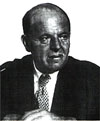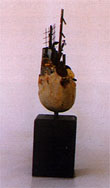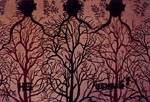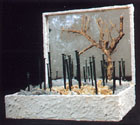

G R E E N N O T C E M E N T
A R T I S T S F O L L O W P O E T H . N . B I A L I K
Doron Polak about new Art and Ecology exhibition in Beit Bialik Tel-Aviv Israel

Haim Nahman Bialik loved the city of Tel Aviv with all his heart. The citizens of Tel Aviv invited the poet as he immigrated to Israel to live in a house dwelling in greenery which was donated to him by the city and later became a center of pilgrimage. Bialik's publicist writing and involvement in the community played an important role influencing the leaders of Tel Aviv in those days and the citizens, opinions, even beyond his immense contribution to the Hebrew literature, prose and poetry. It is amazing to discover, that Bialik's words, in an article which was published at the beginning of the 30's about the dangers hidden in not strictly keeping high standards of quality of the environment in The white city -Tel Aviv- still hold even today. Bialik writes in his essay, that the city of Tel Aviv was meant to be a spa city, a place of relaxation and healing, with a clean beach and golden sands, clean streets, designed houses built according to a program shops that keep an aesthetic unity, and beyond all that- a green city with gardens and parks like the cities in Europe. He points out, that in spite of all the utopian planning, the real situation is not that which was planned. The poet's prophesy, the sharp criticism of the outstanding artist and creator Bialik, of what was happening and what would happen in Tel Aviv, is the thought behind the Green, not cement! exhibition This exhibition brings out the voices and protest of the metropolis dwellers, the artists of the city which is Israel's center of creativity and cultural activity, as they watch the city's green areas disappear sacrificed for the sake of more and more cement skyscrapers.
The ecological challenges of today are not connected only to scientific technical problems which demand an ecological engineering solution; they are connected also to essential social and cultural subjects which demand a political, intellectual and artistic investigation as well writes Mira Angler from Iowa university in the U.S.A., with the Israeli artist Shai Zakai, in an article they wrote for the Ecology and Art conference which took place last year in israel. She adds: There are possibilities for solutions, restoration and remodeling the dialectic interrelationship between Mankind and nature, between environment and culture amongst the different disciplines which investigate the subject. Artists began to address ecological issues in the 20th century following the increased industrial development in the beginning of the century, and focussed in the 60's on the current of Earthworks which dealt with landscape works, soil and the earth itself. David Pfeifer writes in his book New horizons- the history of Painting and Sculpture that a few purist Art critics, who fanatically
guard the flame of Pure Art find in it an ideology which promotes a Return to Nature, tends to an Archaism and artificial primeval essence, a nostalgic aspiration to fogy Romanticism.
An Earthworks artist well known for his achievements is Christo who in the 60's performed Ecological Projects such as blocking the Visconti st. in Paris with a wall made of fuel barrels (Iron curtain) The projects which gave him international fame - his wrapping projects - included the Kunsthalle building in Bern, Switzerland (1968), the Running Fence- 4 kilometers of nylon fabric along two counties in Northern California (1976), and  the wrapped Coast in Little Bay, Australia (1969) where he packed an area of one million square feet of rocks on the beach. In the 90's Christo continued with packing the Reichstag building in Berlin - wrapped Reichtag. Other artists who dealt with Earth were: Hamish Fulton who documented landscapes with his camera and than edited them in a totally abstract format, and Richard Long who created sketches of symbols on the ground and brought dirt and stones into museums and galleries as well as plants or wooden scraps (rafters and boards) which were carried by waters and thrown on the beach. The American artist Michael Heizer was defined as one of the bravest and most revolutionary of the creators of Earthworks In double Negative he curved two quarries at a remote mountain cite, wishing to provoke conceptual questions such as which shape is the negative and which is the positive.
the wrapped Coast in Little Bay, Australia (1969) where he packed an area of one million square feet of rocks on the beach. In the 90's Christo continued with packing the Reichstag building in Berlin - wrapped Reichtag. Other artists who dealt with Earth were: Hamish Fulton who documented landscapes with his camera and than edited them in a totally abstract format, and Richard Long who created sketches of symbols on the ground and brought dirt and stones into museums and galleries as well as plants or wooden scraps (rafters and boards) which were carried by waters and thrown on the beach. The American artist Michael Heizer was defined as one of the bravest and most revolutionary of the creators of Earthworks In double Negative he curved two quarries at a remote mountain cite, wishing to provoke conceptual questions such as which shape is the negative and which is the positive.
A similar dichotomy is found also in the works of Walter De Maria who created Earth works but had also produced traditional objects of sculptural forms. In 1968 he exhibited in Munich a gallery filled with 45 square meters of old dirt. The most famous Earth artist is Robert Smithson, who used landscape as raw material and chose cites where he could confront the issue of the endless fertility of nature with the issues of decay and withering, shriveling, petrifaction and crumbling. Another artist, Hans Haacke, a German who lived in New York, dealt with creating installations of complete miniature ecological systems in art galleries and with surveys about ownership patterns of lands in Manhattan, New York. Haacke brings up in his works Socio-ecological problems. In the 70's, two more American artists created meaningful symbolic ecological art works, dealing with the relationship of the citizen and his residential environment and it's turning into an industrialized polluted living space: Mierle Ukeles created a provocative live performance in which she met the
garbage track drivers in New York and performed a ceremony in which she shook hands with them to express solidarity, Ukeles turned the industrial hangars of the garbage dumps to huge cites of creativity. While visiting Mitzpe Ramon, Israel, in 1995, she created a hill made of broken glass bottles in which she put letters containing the dreams of the residents of the place who wrote them.

In the 70's Agnes Denes planted a field of wheat near the center of Manhattan Wall St. stock market. Denes tends to include forests with thousands of trees in her works and in the 90's she sculpted a huge real mountain of planted trees in Finland. A meaningful ecological artistic project has been done this year at the Tel Aviv Museum, by artists confronting the scrap mountain at Hiria, Israel. Another type of challenging ecological problems can be attributed to artists who performed re-use and recycling of second- hand and used objects and of remnants of industrial materials, which were collected at scrap centers: Marcel Duchamp who became the most prominent of the artists of the 20th century put a toilet seat into an art gallery, along with bicycle wheels and parts of different pieces of furniture The French artist Arman in his exhibition this year at the Tel Aviv Museum, exhibited monumental sculptures made of different parts of furniture and old objects. The American artist Edward Kienholz combined furniture parts, warnout dolls and used objects to create his dramatic installations. Louiz Nevelson created assemblages in which she cast immense walls built of wood and filled with casual objects which went through a process of change, or with different parts of furniture that she painted with monochromatic colors, which created an environmental temple.
Andy Warhol and Roy Lichtenshtein who took a major part in forming American Pop Art, created works based on recycling mass production products as a part of their protest against the brainwashing of the masses. A great part of their work can be interpreted as a direct protest against flooding the market with packages of consumption products which cause eventually the creation of garbage quantities which, in their turn, demand solutions of recycling.
The Ecological Art is being identified today, according to artist Shai Zakai, with Recovery Art, which started in the beginning of the 80's to give specific
 solutions to local problems, and mainly to physically recover vulnerable environments. Concerning recovery of the environment and dealing with ecological problems it is important to mention two central Israeli artists who performed historical
projects: Yitzhak Dantziger, an artist and a teacher,
who initiated the recovery of the Nesher quarry in the Carmel mountain more than twenty years ago, and the artist Avital Geva of kibbutz Ein Shemer, who brought the hot house in which he grows vegetables to the Israeli pavilion at the International Biennale of Art in Venice, who continues to research improve species and study fish, in his Kibbutz.
solutions to local problems, and mainly to physically recover vulnerable environments. Concerning recovery of the environment and dealing with ecological problems it is important to mention two central Israeli artists who performed historical
projects: Yitzhak Dantziger, an artist and a teacher,
who initiated the recovery of the Nesher quarry in the Carmel mountain more than twenty years ago, and the artist Avital Geva of kibbutz Ein Shemer, who brought the hot house in which he grows vegetables to the Israeli pavilion at the International Biennale of Art in Venice, who continues to research improve species and study fish, in his Kibbutz.
The voluntary organization Committees of the heart of the city of Tel Aviv, also known as Green, Not Cement! following an idea of Michal Barzel Cohen the founder
of the organization, initiated and produced the Green, Not Cement!- artists following poet H. N. Bialik exhibition The volunteers turned to artists as part of their Direct Action
activity, asked them to select works they created relating to the desperate need and lack of greenery in Tel Aviv, and to express their feelings about it. The informal independent and authentic act of producing this exhibition has a uniqueness and meaning in that beyond its being a theme exhibition, it properly represents the protest of different artists - there is a great diversity of artists from different parts of Israel's society, and art works of many styles. Naturally, a group of artists deals with the terrible results of the process of destroying the green views in Tel Aviv and its possible apocalyptic future results. Anat Ben Shaul hints in her painting at possibilities of using - as done with virtual reality - a remote control unit to organize the view, evoking the association of what could be the intervention of non-green factors in the view.
Yuval Shaul designs an object similar to a tree, made of hair which was
 separated from its origin, and the artist Tami Nahshon exhibits a tree of used IV bags a
symbol of the need to pour some new life into the city. Hana Barak angel ties a tree with heavy metal chains, Jacob Bernstein sculpts a cement egg with scrap materials pouring out of it and Moshe Amar paints with his computer a city which he calls cement leaf.
Other artists relate to the public transportation which overflow the city and pollute it: Shimon Avni paints a car far from being clean, hinting at an origin of environmental pollution, and Yasha Zirinski shows in his work cars dumped in dirty mud a warning concerning the future of the packed roads of the city.
separated from its origin, and the artist Tami Nahshon exhibits a tree of used IV bags a
symbol of the need to pour some new life into the city. Hana Barak angel ties a tree with heavy metal chains, Jacob Bernstein sculpts a cement egg with scrap materials pouring out of it and Moshe Amar paints with his computer a city which he calls cement leaf.
Other artists relate to the public transportation which overflow the city and pollute it: Shimon Avni paints a car far from being clean, hinting at an origin of environmental pollution, and Yasha Zirinski shows in his work cars dumped in dirty mud a warning concerning the future of the packed roads of the city.
Naturally, most of the artists deal with the green areas and with the need to take care of the disappearing trees and plants. Tzibi Geva exhibits a window with a tree, John Byle dreams of a forest of green trees, Rachel Shavit paints a green field in the middle of the city, and Buki Schwartz blows a photograph of a field on top of distant gray skyscrapers to the size of a huge billboard.
Moshe Gershuni presents a symbolic comparison of a green area opposite a dark area, which he calls Green Wins, and Rafi Lavi presents a work that deals with the local poor materials and can be interpreted as a hint of the poor condition of the organic sources around us, The artists Nahum Tevet and Ido Bar El present symbolic similar works which deal with minimalist creations relating to an object's contact and relations with the environment in which it exists.
Menashe Kadishman exhibits a typical work of his and with his symbolic sheep expresses relation to nature, environment, and the animals in it.
Many artists deal with Meir Park, the central green park in the heart of the city that represents for them a controversial green spot. Meir Park is one of the most prominent issues in Bialik's essay. Ronit Etrog photographs a lonely tree in that park, Ofer Lellouche exhibits wood curving prints showing the views of the park, Shir and Lea Shvadron paint romantic scenes of the garden and Avraham Pesso paints a green corner. Yehuda Porbuchrai exhibits a naive swan lake hinting at the condition of the central pond in the park.
Personal symbols and signs expressing dream, longing for the green or even a childhood memory can be found in the works of Naomi Siman Tov who painted a portrait of a mother and green-eyed child, Arie Berkowitz painting a lonely flower, Michail Grobman who painted trees that look like blood veins, Yoav Ben Dov with a sculpture of wheat sheaf which look like it was taken out of a romantic view painting. Relli De Vries exhibits a sole tile with two sides - one clean and painted and the other which still carries remnants of cement.

Ofra Moran's sculpture deals with womb and ovaries, a symbol of the
natural organism being destroyed. A few works relate directly to H.N.Bialik and the article which triggered this exhibition Igael Tumarkin exhibits a work which includes casts of Bialik's head with a line from one of his poems written on it. Avraham Binder the veteran artist paints a portrait of Bialik representing the poet wearing a worried fatherly expression with the words Bialik's angry prophesy.
This article is too short to tell about all the artists and their works. The importance of the project is in the variety of opinions expressed in different ways about the same subject through the artists' works, and in the fact that they care and are represented in this exhibition. The independent self-organizing act of the activists and the artists in a direct protest exhibition that takes art out of the peace and quiet and stillness of the museums to the streets, to the public space, to that which is
present and painful here and now, is the main issue, a message that must reach the hearts of the decision makers.
April 2000
IMAGES TAKEN FROM THE EXHIBITION CATALOGUE
Back to news |
Back to homepage |
Jump to top
 the wrapped Coast in Little Bay, Australia (1969) where he packed an area of one million square feet of rocks on the beach. In the 90's Christo continued with packing the Reichstag building in Berlin - wrapped Reichtag. Other artists who dealt with Earth were: Hamish Fulton who documented landscapes with his camera and than edited them in a totally abstract format, and Richard Long who created sketches of symbols on the ground and brought dirt and stones into museums and galleries as well as plants or wooden scraps (rafters and boards) which were carried by waters and thrown on the beach. The American artist Michael Heizer was defined as one of the bravest and most revolutionary of the creators of Earthworks In double Negative he curved two quarries at a remote mountain cite, wishing to provoke conceptual questions such as which shape is the negative and which is the positive.
the wrapped Coast in Little Bay, Australia (1969) where he packed an area of one million square feet of rocks on the beach. In the 90's Christo continued with packing the Reichstag building in Berlin - wrapped Reichtag. Other artists who dealt with Earth were: Hamish Fulton who documented landscapes with his camera and than edited them in a totally abstract format, and Richard Long who created sketches of symbols on the ground and brought dirt and stones into museums and galleries as well as plants or wooden scraps (rafters and boards) which were carried by waters and thrown on the beach. The American artist Michael Heizer was defined as one of the bravest and most revolutionary of the creators of Earthworks In double Negative he curved two quarries at a remote mountain cite, wishing to provoke conceptual questions such as which shape is the negative and which is the positive.




 solutions to local problems, and mainly to physically recover vulnerable environments. Concerning recovery of the environment and dealing with ecological problems it is important to mention two central Israeli artists who performed historical
projects: Yitzhak Dantziger, an artist and a teacher,
who initiated the recovery of the Nesher quarry in the Carmel mountain more than twenty years ago, and the artist Avital Geva of kibbutz Ein Shemer, who brought the hot house in which he grows vegetables to the Israeli pavilion at the International Biennale of Art in Venice, who continues to research improve species and study fish, in his Kibbutz.
solutions to local problems, and mainly to physically recover vulnerable environments. Concerning recovery of the environment and dealing with ecological problems it is important to mention two central Israeli artists who performed historical
projects: Yitzhak Dantziger, an artist and a teacher,
who initiated the recovery of the Nesher quarry in the Carmel mountain more than twenty years ago, and the artist Avital Geva of kibbutz Ein Shemer, who brought the hot house in which he grows vegetables to the Israeli pavilion at the International Biennale of Art in Venice, who continues to research improve species and study fish, in his Kibbutz.
 separated from its origin, and the artist Tami Nahshon exhibits a tree of used IV bags a
symbol of the need to pour some new life into the city. Hana Barak angel ties a tree with heavy metal chains, Jacob Bernstein sculpts a cement egg with scrap materials pouring out of it and Moshe Amar paints with his computer a city which he calls cement leaf.
Other artists relate to the public transportation which overflow the city and pollute it: Shimon Avni paints a car far from being clean, hinting at an origin of environmental pollution, and Yasha Zirinski shows in his work cars dumped in dirty mud a warning concerning the future of the packed roads of the city.
separated from its origin, and the artist Tami Nahshon exhibits a tree of used IV bags a
symbol of the need to pour some new life into the city. Hana Barak angel ties a tree with heavy metal chains, Jacob Bernstein sculpts a cement egg with scrap materials pouring out of it and Moshe Amar paints with his computer a city which he calls cement leaf.
Other artists relate to the public transportation which overflow the city and pollute it: Shimon Avni paints a car far from being clean, hinting at an origin of environmental pollution, and Yasha Zirinski shows in his work cars dumped in dirty mud a warning concerning the future of the packed roads of the city.
